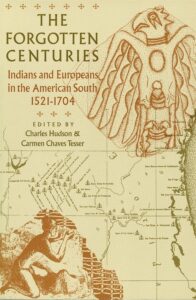NOTE: THIS WEBSITE IS A WORK IN PROGRESS. RESOURCES AND DATA ARE ADDED DAILY.
IMPORTANT: We are in urgent need of funding to keep this project alive and ensure its future. If you’re enjoying the site and see our vision for the project, please consider joining as a paid member or contributing to our crowdfunding campaign today. It is only with your help that we can continue this work.
Thanks so much for your support! – Jes
![]()
The Forgotten Centuries: Indians and Europeans in the American South 1521-1704
share:
Some buttons on this page link to external websites. If you visit one of our affiliate sites and make a purchase, I may receive a small commission at no extra cost to you. More info
- UPDATED: 6.17.2025
- status: high-priority, to be worked
- American History, Indigenous History, History
author:
Charles M. Hudson, Carmen Chaves Tesser
editor:
n/a
publisher:
date:
7.1.1994
ISBN:
9780820316543
pages:
480
notes:
contents:
description:
Using the chronicles of the Spanish soldiers and adventurers, the contributors survey the emergence and character of the chiefdoms of the Southeast. In addition, they offer new scholarly interpretations of the expeditions of Lucas Vasquez de Ayllon from 1521 to 1526, Panfilo de Narvaez in 1528, and most particularly Hernando de Soto in 1539-43, as well as several expeditions conducted between 1597 and 1628.
The essays in this volume address three other connected topics. Describing some of the major chiefdoms - Apalachee, the "Oconee" Province, Cofitachequi, and Coosa--the essays undertake to lay bare the social principles by which they operated. They also explore the major forces of structural change that were to transform the chiefdoms: disease and depopulation, the Spanish mission system, and the English deerskin and slave trades. And finally, they examine how these forces shaped the history of several subsequent southeastern Indian societies, including the Apalachees, Powhatans, Creeks, and Choctaws. These societies, the so-called native societies of the Old South, were, in fact, new ones formed in the crucible fired by the economic expansion of the early modern world.
CMOS:
author-date:

